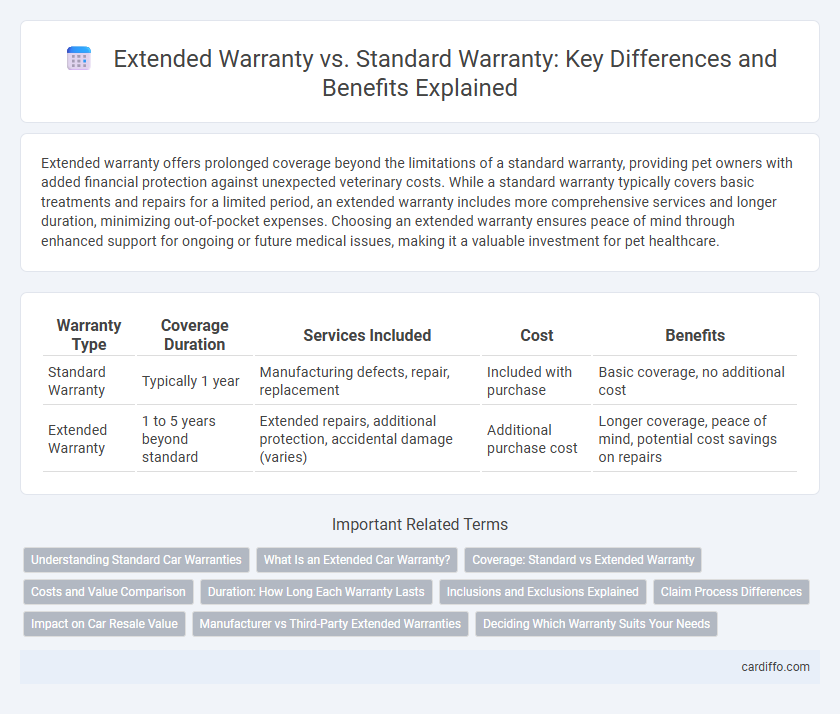Extended warranty offers prolonged coverage beyond the limitations of a standard warranty, providing pet owners with added financial protection against unexpected veterinary costs. While a standard warranty typically covers basic treatments and repairs for a limited period, an extended warranty includes more comprehensive services and longer duration, minimizing out-of-pocket expenses. Choosing an extended warranty ensures peace of mind through enhanced support for ongoing or future medical issues, making it a valuable investment for pet healthcare.
Table of Comparison
| Warranty Type | Coverage Duration | Services Included | Cost | Benefits |
|---|---|---|---|---|
| Standard Warranty | Typically 1 year | Manufacturing defects, repair, replacement | Included with purchase | Basic coverage, no additional cost |
| Extended Warranty | 1 to 5 years beyond standard | Extended repairs, additional protection, accidental damage (varies) | Additional purchase cost | Longer coverage, peace of mind, potential cost savings on repairs |
Understanding Standard Car Warranties
Standard car warranties typically cover manufacturer defects and repairs for a limited period, often 3 years or 36,000 miles. These warranties include components such as the powertrain, engine, transmission, and essential electronics. Understanding standard coverage limits helps consumers evaluate the potential benefits of purchasing an extended warranty for additional protection beyond original terms.
What Is an Extended Car Warranty?
An extended car warranty is a service contract that prolongs the coverage of repairs and maintenance beyond the standard warranty period provided by the manufacturer. It typically covers major vehicle components such as the engine, transmission, and electrical systems, offering additional protection against unexpected mechanical failures. Unlike a standard warranty, which is included with a new car purchase and lasts for a limited time or mileage, an extended warranty must be purchased separately and can be customized to fit specific needs.
Coverage: Standard vs Extended Warranty
Standard warranty typically covers manufacturing defects and malfunctions for a limited period, often one year, providing basic protection and repair services. Extended warranty expands this coverage beyond the standard period, including additional benefits such as accidental damage, parts replacement, and prolonged service support. Consumers benefit from extended warranties through enhanced coverage, reduced out-of-pocket repair costs, and increased product lifespan assurances.
Costs and Value Comparison
Extended warranties typically cost 20-60% more than standard warranties but offer prolonged coverage beyond the manufacturer's basic 12-24 month period. While standard warranties cover essential repairs and defects, extended warranties often include additional services like accidental damage protection and 24/7 support, enhancing overall value. Consumers must evaluate the expected repair costs and product lifespan to determine if the upfront extended warranty expense justifies potential savings and peace of mind.
Duration: How Long Each Warranty Lasts
Extended warranties typically last beyond the standard warranty period, providing coverage for several additional years depending on the product and provider. Standard warranties usually cover a limited time frame, often one to two years from the date of purchase, ensuring repair or replacement for manufacturing defects. Consumers should compare specific duration terms to maximize protection and avoid gaps in warranty coverage.
Inclusions and Exclusions Explained
Extended warranty offers broader coverage beyond the standard warranty by including additional repairs, parts replacement, and sometimes accidental damage protection not covered under the basic plan. Standard warranty typically covers manufacturer defects and malfunctioning parts for a limited time or usage period, excluding wear and tear, accidental damage, and user-induced issues. Customers should carefully review the inclusions such as labor, parts, and specific conditions, as well as common exclusions like cosmetic damage, misuse, and unauthorized modifications to ensure optimal protection.
Claim Process Differences
Extended warranty claim processes often require activation and registration, whereas standard warranty claims typically begin immediately upon purchase. Extended warranties may involve more detailed documentation and sometimes longer approval times due to third-party administration. Standard warranty claims usually process directly through the manufacturer, ensuring quicker service and straightforward compliance with initial purchase terms.
Impact on Car Resale Value
Extended warranty coverage often enhances car resale value by offering buyers additional assurance against unexpected repair costs, making the vehicle more attractive in the used car market. Standard warranties, while providing basic protection, typically expire sooner, reducing perceived value over time. Vehicles sold with active extended warranties can command higher prices and faster sales compared to those relying solely on standard factory warranties.
Manufacturer vs Third-Party Extended Warranties
Manufacturer extended warranties often provide seamless coverage aligned with the original product warranty, ensuring genuine parts and authorized service centers. Third-party extended warranties can offer more flexible terms and broader protection options, but may vary significantly in reliability and service quality. Consumers should evaluate warranty duration, coverage specifics, claim processes, and provider reputation when choosing between manufacturer and third-party extended warranty options.
Deciding Which Warranty Suits Your Needs
Extended warranty offers prolonged coverage beyond the standard warranty period, ideal for those seeking long-term protection against repairs and defects. Standard warranty typically includes basic manufacturer coverage limited to a specific time frame or usage, suitable for users with minimal risk tolerance or shorter product usage plans. Evaluating product reliability, usage frequency, and repair costs helps determine whether the added expense of an extended warranty aligns with your protection needs and budget.
Extended Warranty vs Standard Warranty Infographic

 cardiffo.com
cardiffo.com